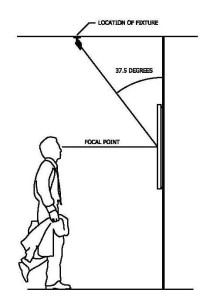Home Lighting
By Craig DiLouie, LC

Frontal smooth washing of a wall, without scalloping. Photo: Michael Spillers Photography
Want to add a visual punch to a wall without painting it or hanging art? Try lighting it instead. Wall grazing and washing are two techniques that can add character to your room’s walls. Each method addresses a different type of wall. The first (Wall A) is white-painted drywall that we want to see as a smooth, blank surface. The second (Wall B) is natural stone, which we want to see as roughly textured.
We can light Wall A using a technique called wall washing. This technique entails uniformly lighting a wall from top to booth in a smooth graded wash, hiding any imperfections and blemishes by eliminating their shadows. The wall appears bright and draws attention to the architecture as a luminous background for people and furniture. By emphasizing the architecture, the lighting makes the room appear larger and more spacious.

The wall-wash lights must be mounted at a sufficient distance from the wall to ensure a smooth graded wash of light. Drawing by Bruce Yarnell, IALD, MIES, LC
Wall washing is typically produced by lights mounted at or above the ceiling that effectively wash up to 8-9 feet of vertical wall space. The wall-wash lights should be mounted at a sufficient distance from the wall so that light falls on the wall at a wider angle; in some spaces, 2.5-3 feet might be suitable.
While wall washing reveals the smooth surface of Wall A, it would wash out the rich stone texture of Wall B. Alternately, we can light Wall B using a technique called grazing. Grazing is similar to wall washing in practice but the lights are located closer to the wall. The beam of light strikes the wall at a narrower angle, producing shadowing that reveals and accentuates texture. By moving the lights closer or farther away from the wall, we can adjust the angle of light to make the shadowing more or less pronounced. Either way, the wall is presented as a point of visual interest in the space.
Grazing is produced by lights mounted at or above the ceiling. The lights can even be mounted under the floor or ground for an interesting uplight grazing effect. (Take care not to mount uplights in places where viewers typically

A natural stone wall is grazed. Photo: Michael Spillers Photography
stand so as to avoid causing direct glare.) Besides walls, grazing can also be effective for lighting carvings and statues.
Lighting walls can make spaces appear brighter and more spacious, and, in some cases, reveal beauty by highlighting texture. Wall washing and grazing are two techniques for controlling how these surfaces, and the spaces they enclose, are perceived.
What you need to know:
- Wall washing and grazing call attention to walls
- Wall washing lights the wall at a wider angle, washing out details
- Wall washing is ideal for creating a visually smooth, flat surface
- Grazing lights the wall at a narrow angle, accentuating details through shadows
- Grazing is ideal for creating a textured surface for surfaces such as brick and stone